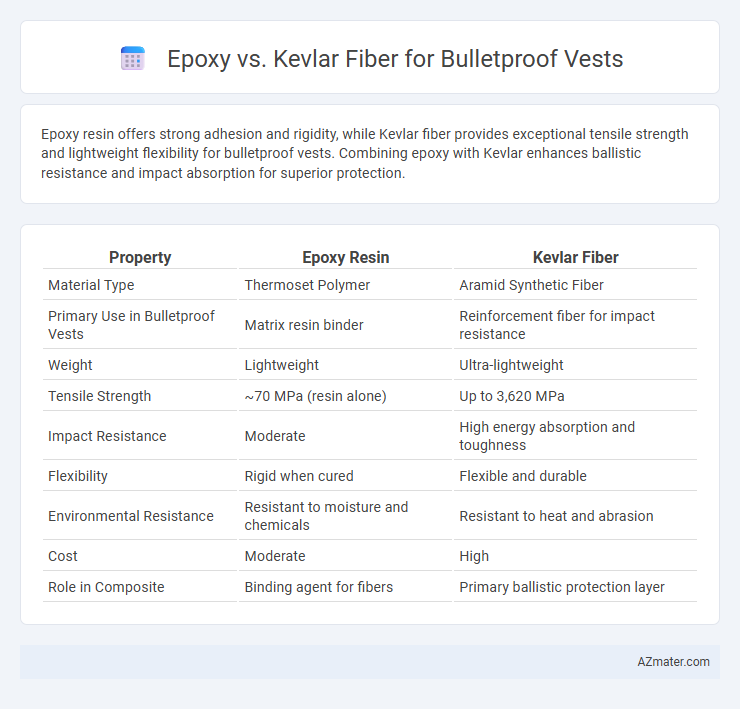Epoxy resin offers strong adhesion and rigidity, while Kevlar fiber provides exceptional tensile strength and lightweight flexibility for bulletproof vests. Combining epoxy with Kevlar enhances ballistic resistance and impact absorption for superior protection.
Table of Comparison
| Property | Epoxy Resin | Kevlar Fiber |
|---|---|---|
| Material Type | Thermoset Polymer | Aramid Synthetic Fiber |
| Primary Use in Bulletproof Vests | Matrix resin binder | Reinforcement fiber for impact resistance |
| Weight | Lightweight | Ultra-lightweight |
| Tensile Strength | ~70 MPa (resin alone) | Up to 3,620 MPa |
| Impact Resistance | Moderate | High energy absorption and toughness |
| Flexibility | Rigid when cured | Flexible and durable |
| Environmental Resistance | Resistant to moisture and chemicals | Resistant to heat and abrasion |
| Cost | Moderate | High |
| Role in Composite | Binding agent for fibers | Primary ballistic protection layer |
Introduction to Bulletproof Vest Materials
Bulletproof vests primarily utilize materials like epoxy-infused composites and Kevlar fibers due to their superior ballistic resistance. Epoxy resins provide structural rigidity and enhance the energy dispersion capabilities when combined with high-strength fibers, creating a durable protective layer. Kevlar, a synthetic aramid fiber known for its exceptional tensile strength and lightweight nature, absorbs and dissipates impact forces efficiently, making it a preferred choice in ballistic armor design.
Understanding Epoxy and Kevlar Fiber
Epoxy is a thermosetting resin known for its strong adhesive properties and high mechanical strength, making it an ideal matrix material in composite bulletproof vests. Kevlar fiber, a synthetic aramid fiber, offers exceptional tensile strength, high energy absorption, and excellent resistance to ballistic impacts, contributing to lightweight yet effective protection. Combining epoxy resin with Kevlar fibers results in a composite material that maximizes durability, flexibility, and impact resistance essential for advanced bulletproof vests.
Key Properties of Epoxy in Ballistic Protection
Epoxy resin exhibits exceptional adhesive strength and high tensile modulus, contributing to superior energy absorption and distribution in bulletproof vests. Its excellent chemical resistance and thermal stability ensure durability under extreme conditions, maintaining integrity against ballistic impacts. The lightweight nature of epoxy-based composites enhances wearer mobility while providing robust protection against projectile penetration.
Key Properties of Kevlar Fiber in Bulletproof Vests
Kevlar fiber exhibits exceptional tensile strength and high energy absorption, making it a prime material for bulletproof vests. Its lightweight nature and resistance to heat and chemical degradation enhance wearer mobility and durability under extreme conditions. The fiber's inherent flexibility allows it to disperse the impact force of ballistic threats efficiently, providing superior protection without sacrificing comfort.
Strength and Durability Comparison
Kevlar fiber offers exceptional tensile strength and flexibility, making it highly effective at absorbing and dispersing ballistic impacts in bulletproof vests. Epoxy, commonly used as a resin matrix in composite materials, provides strong adhesion and rigidity but lacks the inherent toughness and energy absorption capabilities of Kevlar fibers. When comparing strength and durability, Kevlar's ability to withstand repeated stress and maintain its protective properties surpasses epoxy-based composites, ensuring superior long-term performance in ballistic protection.
Weight and Flexibility Analysis
Kevlar fiber exhibits superior flexibility and lower weight compared to epoxy composites, making it the preferred material in bulletproof vests for enhanced mobility and comfort. Epoxy-based vests, while offering high hardness and ballistic resistance, tend to be heavier and less flexible, potentially restricting movement. The lightweight nature of Kevlar, combined with its multi-directional fiber weave, provides optimal balance between protection and ease of wear in tactical applications.
Cost Considerations: Epoxy vs Kevlar
Kevlar fiber offers a high strength-to-weight ratio but comes with a significantly higher cost compared to epoxy resin composites, which are more affordable yet provide moderate ballistic resistance. Epoxy-based materials often require less specialized manufacturing processes, reducing overall production expenses in bulletproof vest fabrication. For budget-conscious defense applications, epoxy composites present a cost-effective option, whereas Kevlar remains the premium choice for maximum protection despite its increased price point.
Practical Applications in Body Armor
Kevlar fiber is widely used in bulletproof vests for its exceptional tensile strength, flexibility, and lightweight properties, enabling effective multi-hit resistance and comfort during prolonged wear. Epoxy resin serves as a hardening matrix in composite body armor to bond layers of fibers like Kevlar, enhancing structural integrity and ballistic protection by distributing impact forces across the vest. Practical applications in body armor often combine Kevlar fibers with epoxy resin to optimize both toughness and durability while maintaining mobility for law enforcement and military personnel.
Safety and Real-World Performance
Kevlar fiber remains the industry standard for bulletproof vests due to its proven high tensile strength and superior energy absorption, effectively stopping handgun and rifle rounds while maintaining flexibility for wearer comfort. Epoxy composites, often used as matrix resins in combination with Kevlar or other fibers, enhance structural rigidity and durability but on their own lack the necessary impact resistance to safely dissipate ballistic forces. Bulletproof vests combining Kevlar fibers with epoxy resin matrices deliver optimal real-world performance by balancing lightweight protection with resistance to blunt force trauma and multi-hit capability.
Conclusion: Best Material Choice for Bulletproof Vests
Kevlar remains the preferred material for bulletproof vests due to its exceptional tensile strength, lightweight nature, and proven ballistic resistance, while epoxy primarily serves as a resin matrix rather than a standalone fiber. Kevlar fibers offer superior multi-hit capability and flexibility, essential for wearer comfort and mobility, whereas epoxy enhances composite rigidity but cannot match Kevlar's energy absorption properties. The optimal bulletproof vest construction integrates Kevlar fibers reinforced with epoxy resin to maximize protection and durability.

Infographic: Epoxy vs Kevlar fiber for Bulletproof vest
 azmater.com
azmater.com